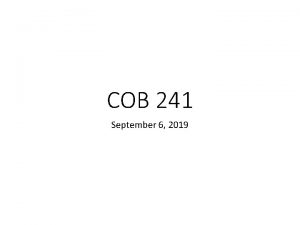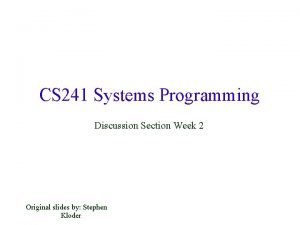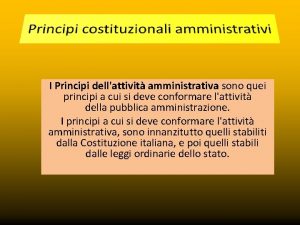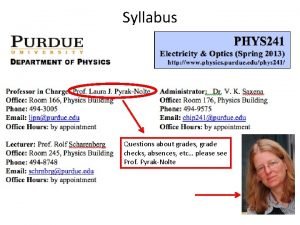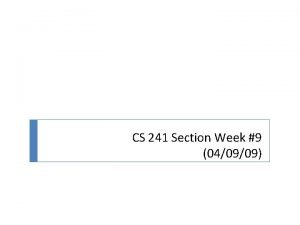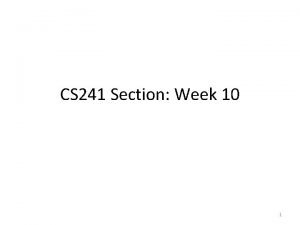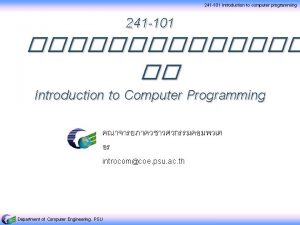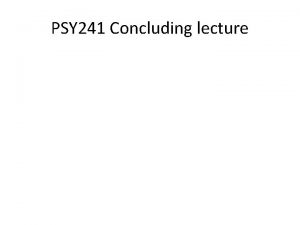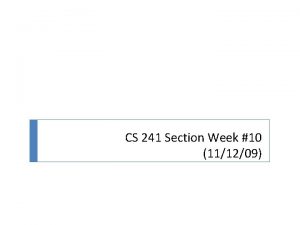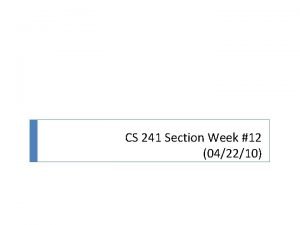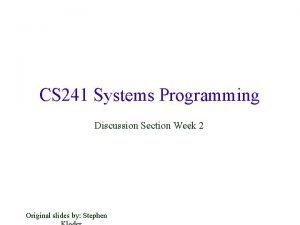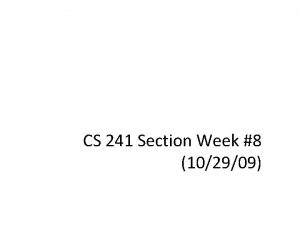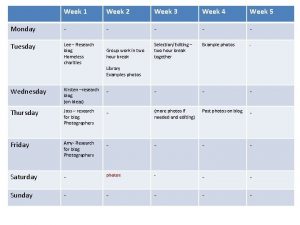CS 241 Section Week 4 092310 Topics This



























- Slides: 27

CS 241 Section Week #4 (09/23/10)

Topics This Section MP #3 MP #4 5 -state Model Review of Scheduling Problems

MP #3

MP #3 qsort() Define your own comparison function int compare (const void *e 1, const void *e 2) { return (*(int*)e 1 - *(int*)e 2); } Merge You need to remove duplicates How do you do that? Pthreads pthread_create and pthread_join You DO NOT want to do this: for ( …) { pthread_create(…); … pthread_join(…); }

MP #4

MP 4 Forward In MP 4, you will add code to a simulator for a CPU scheduler. We provide you with the code for the simulator. You don’t need to understand this code to understand this MP. You should consider the simulator a ‘black box’ You need to implement these algorithms: fcfs, sjf, pri, ppri, rr#

MP 4 Forward You need to fill in 3 scheduling functions: scheduler_new_job() scheduler_job_finished() scheduler_quantum_expired() Note that these are the only times that the scheduler needs to make a decision! A scheduler_clean_up() function to clean up any memory your program may’ve allocated A scheduler_show_queue() function to help you debug your program You need to create your own job queue

MP 4 Forward You also need to fill in 3 statistics functions: float scheduler_average_response_time() float scheduler_average_wait_time() float scheduler_average_turnaround_time() These are called at the end of the simulation.

MP 4 Forward For success on this MP: Carefully read instructions for all details! Look at the example runs and compare your results (e. g. using ‘diff’)! Only the last five lines matter. . . depends on how you implement the optional _show_queue(). Requires a good understanding of data structures, scheduling, and pointers all in one MP! Good luck!

Five State Model

5 -State Model - Transitions 11

Review of Scheduling

Scheduling The CPU Scheduler decides which thread should be in the running state. It is called when: A thread is created or finishes A clock interrupt occurs An I/O interrupt occurs A thread yields

Scheduling The algorithms that we usually talk about are: First-Come First-Serve (FCFS) Shortest Job First (SJF) Priority Round Robin (RR)

FCFS Example Process P 1 P 2 P 3 P 4 Duration 6 8 7 3 P 1 0 Priority 4 1 3 2 P 2 6 Arrival Time 0 0 P 3 14 P 4 21 24

SJF Example Process P 1 P 2 P 3 P 4 0 Duration 6 8 7 3 P 1 3 Priority 4 1 3 2 Arrival Time 0 0 P 3 9 P 2 16 24

Priority Example Process P 1 P 2 P 3 P 4 Duration 6 8 7 3 P 2 0 P 4 8 Priority 4 1 3 2 Arrival Time 0 0 P 3 11 P 1 18 24

RR(1) Example Process P 1 P 2 P 3 P 4 Duration 6 8 7 3 Priority 4 1 3 2 Arrival Time 0 0 Quanta = 1 time unit P 1 P 2 P 3 P 4 0 12 19 24

Scheduling algorithms can be preemptive or nonpreemptive Non-preemptive: each thread chooses when to yield to the processor (e. g. when done or system call) Preemptive: scheduler forces the thread to yield (e. g. time quantum expires in RR)

Scheduling Metrics for a single job Response time = time from job submission until it’s running Waiting time = total time that the job is not running but queued Turnaround time = time b/t the job’s entry and completion

Problems

Problem #1 Job Duration Priority # J 1 6 2 J 2 4 1 J 3 5 1 These three jobs are going to arrive at our scheduler 1 time unit apart from each other (i. e. one job at time 0, one at time 1, and one at time 2), but the order hasn’t been decided yet.

Problem #1 We want to guarantee that the jobs finish in the order J 1 then J 2 then J 3

Problem #1 Which arrival order(s) guarantee this if the scheduler uses: 1) 2) 3) 4) 5) 6) FCFS? non-premptive SJF? preemptive SJF? (use remaining time, and ties are broken by arrival time) RR-1? (arriving jobs are placed on ready queue immediately) non-preemptive priority?

Problem #2 For the SJF and RR examples, calculate: 1) 2) 3) Average initial waiting time Average response time Are either of these clearly better? When would you use each?

SJF Example Process P 1 P 2 P 3 P 4 0 Duration 6 8 7 3 P 1 3 Priority 4 1 3 2 Arrival Time 0 0 P 3 9 P 2 16 24

RR(1) Example Process P 1 P 2 P 3 P 4 Duration 6 8 7 3 Priority 4 1 3 2 Arrival Time 0 0 Quanta = 1 time unit P 1 P 2 P 3 P 4 0 12 19 24
 Week by week plans for documenting children's development
Week by week plans for documenting children's development Nfpa 241
Nfpa 241 Charging by induction
Charging by induction 241 bce
241 bce 427 266 to the nearest ten thousand
427 266 to the nearest ten thousand Fon 241
Fon 241 Cob 241
Cob 241 Ceng 241
Ceng 241 Psyco 241
Psyco 241 Cs 241 vector mp
Cs 241 vector mp Ceng 241
Ceng 241 Chm 241
Chm 241 Definition of detail drawing
Definition of detail drawing Mappa concettuale legge 241/90
Mappa concettuale legge 241/90 Eee 241
Eee 241 Legge 241/90 slide
Legge 241/90 slide Purdue phys 241
Purdue phys 241 Bio 241
Bio 241 241 in arabic
241 in arabic Revolved sectional view
Revolved sectional view What is a removed section view
What is a removed section view What is half section view
What is half section view Section 2 describing energy (continued)
Section 2 describing energy (continued) Study guide chapter 10 section 1 meiosis
Study guide chapter 10 section 1 meiosis Article writing school magazine
Article writing school magazine Grade 9 persuasive writing
Grade 9 persuasive writing What is a thematic paragraph
What is a thematic paragraph Behavioural training topics
Behavioural training topics






